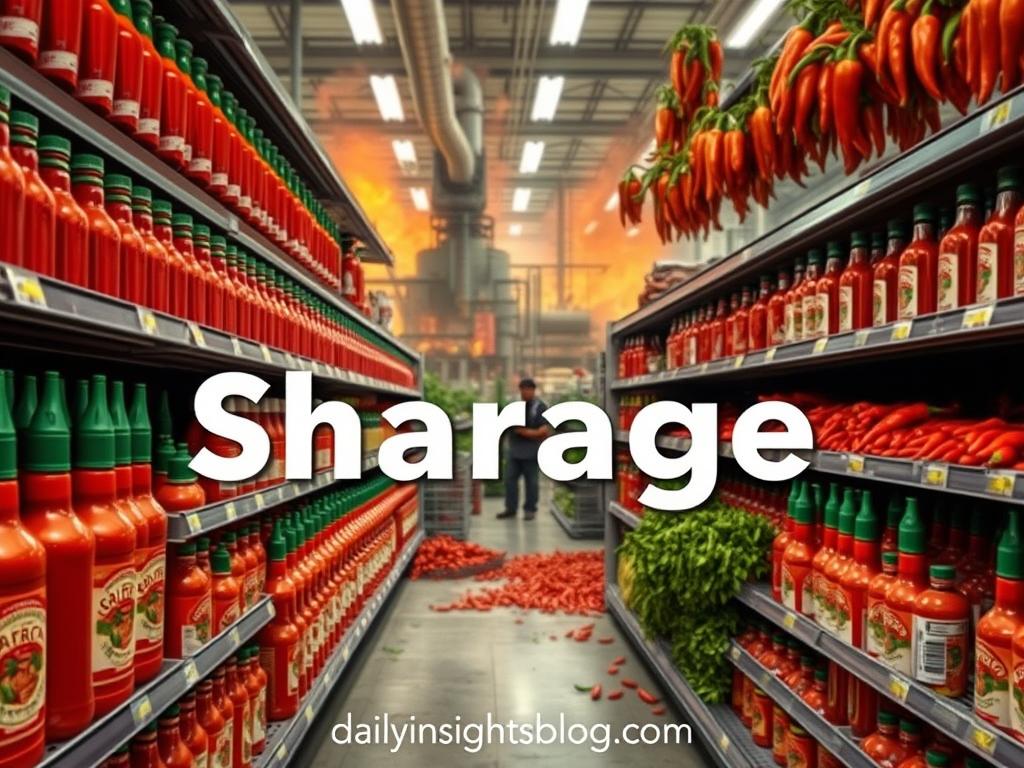If you love sriracha, you’ve probably heard about the shortage. Bottles of Huy Fong Foods’ sriracha were selling for up to $80 online. This has left many in the US searching for their favorite hot sauce.
The issue started with a problem in the supply chain. Huy Fong Foods and its pepper supplier, Underwood Ranches, had a legal fight. This ended their partnership, leaving Huy Fong without peppers for sriracha.
Weather problems in the southwest have also hurt pepper production. Huy Fong is now getting peppers from other places. But this has made their hot sauce harder to find, leaving stores empty and people upset.
The Rise of Sriracha’s Popularity
Sriracha, the fiery-red chili-garlic sauce, has become a hit in the US. Its fame is thanks to Vietnamese refugee David Tran, Huy Fong Foods’ founder. In 1980, Tran started selling his sriracha in Los Angeles, mainly to immigrant communities.
David Tran’s Iconic Recipe
Tran’s sriracha recipe, made from fresh red jalapeños, sugar, garlic, vinegar, and preservatives, won many fans. Its unique taste and the rooster logo made it a top hot sauce brand. Now, sriracha is in one in ten American kitchens and even on the International Space Station.
From Niche Product to Mainstream Success
Sriracha’s journey from a niche item to a big hit shows how tastes in America have changed. Between 2000 and 2013, hot sauce sales soared, with sriracha leading the way. Today, the hot sauce market is worth billions, and 16% of young households have sriracha.
Sriracha’s fame has spread beyond cooking, appearing in products like lip balm and candy canes. Its success has also led to many copycat products and legal fights over its name. Yet, Huy Fong Foods keeps making its iconic sauce, sold in over 40 countries, making it a global icon.
The Chili Pepper Supply Chain Breakdown
For over 28 years, Underwood Ranches in Ventura County, California, was the only supplier of red jalapeño peppers to Huy Fong Foods. The two companies had a strong partnership. Huy Fong’s founder, David Tran, and Underwood became close friends over the years.
Craig Underwood’s Exclusive Supplier Role
Underwood Ranches gave Huy Fong the high-quality peppers needed for sriracha. This partnership helped Huy Fong keep its product consistent and of high quality. As a result, sriracha became a favorite in many homes and restaurants across the U.S.
The Fallout from the Partnership Dissolution
In 2016, a payment dispute ended the partnership between Underwood Ranches and Huy Fong Foods. This left Huy Fong without a reliable pepper source. Underwood Ranches was left with a large crop and no buyer.
The dispute led to legal battles and financial losses for both companies. It also caused sriracha shortages on store shelves. Huy Fong struggled to find new pepper sources, including Mexico, New Mexico, and California. The company had to pay $23.3 million in 2019 due to the dispute.
| Event | Impact |
|---|---|
| Huy Fong Foods’ partnership with Underwood Ranches dissolved |
|
| Huy Fong struggled to source jalapeños from other growers |
|
The supply chain breakdown between Underwood Ranches and Huy Fong Foods has affected sriracha availability. This shortage has impacted consumers and businesses, making it hard to find the beloved sauce.
sriracha shortage and Its Impact
The supply chain issue between Huy Fong Foods and Underwood Ranches, along with bad weather in pepper-growing areas, has caused a sriracha shortage. Now, finding bottles of hot sauce is hard, and prices have skyrocketed to up to $80 online on the sriracha resale market.
Without Huy Fong’s sriracha, other brands like Tabasco and Roland have stepped in. They offer their own versions, and supermarkets have their own generic hot sauces. But many fans still want the original Huy Fong sriracha. This demand is hard for the company to meet because of the sriracha supply issues.
Dwindling Supplies and Resurgence of Competitors
Huy Fong, Inc., the maker of Sriracha sauce, had trouble with supply lines during the COVID-19 pandemic. But by fall 2022, they were back to making Sriracha at a normal rate.
The Sriracha shortage is still going on because of supply chain problems. Drought in Mexico has made chili peppers rare. People can’t find Sriracha in stores or online, and there’s no clear date for when it will be back.
While Huy Fong’s Sriracha is hard to find, other brands like Tabasco, Tapatio, and Louisiana Hot Sauce are becoming popular sriracha alternatives. They offer different heat levels to satisfy Sriracha fans.
Local producers, like Carrot Pepper Hot Sauce from Splash Café in Pismo Beach, California, are also making tasty sriracha alternatives during the shortage.
Climate Change’s Role in Chili Pepper Shortages
The ongoing sriracha shortage is just one example of how climate change is impacting the global supply of chili peppers. Regions like northern Mexico, where much of the red jalapeño crop is grown, have been plagued by severe drought in recent years. This drought has drained water resources and decimated pepper fields. Extreme weather events have also taken a toll on pepper crops in other parts of the world.
Drought and Extreme Weather’s Effects
Experts say that as temperatures continue to rise, growing chili peppers will become more challenging. Heat stress and increased susceptibility to pests and diseases will become more common. The failed chili pepper harvest in northern Mexico, the source of chilies used in sriracha, was attributed to a two-year drought exacerbated by climate change.
The region, encompassing southwestern U.S. and northern Mexico, is facing a “megadrought.” It is the driest in 22 years and connected to human-induced climate change.
Challenges in Breeding Heat-Tolerant Varieties
Researchers are working to develop more drought- and heat-tolerant pepper varieties. However, the physiological limits of the plants may make it difficult to completely offset the effects of climate change on chili pepper production and supply. Limiting global warming to below 2 degrees Celsius is highlighted as a significant factor in mitigating the impact of climate change on water scarcity and agricultural production in the region.
Conclusion
The sriracha shortage warns us about the global food system’s weaknesses. It shows how climate change and supply chain issues can affect our favorite foods. This shortage might be a sign of what’s to come for other food products.
Huy Fong Foods, once a big player in the hot sauce market, now faces a tough time. The company used to have a 6.3% share of the $2.6 billion hot sauce market. But now, they’re dealing with a shortage due to a change in their pepper supplier.
The hot sauce market in the U.S. is expected to grow to $2.8 billion by 2028. The sriracha shortage highlights the need for sustainable and adaptable solutions. It shows us the importance of finding ways to overcome these challenges for the future of food.




